The Mammalian, Reptilian and Amphibian Fauna of Al-Mawasi Ecosystem, South-Western Gaza Strip – Palestine
Abdel Fattah N Abd Rabou*
Department of Biology, Islamic University of Gaza, Palestine
Submission:August 20, 2019 Published: November 25, 2019
*Corresponding author:Abdel Fattah N Abd Rabou, Department of Biology, Faculty of Science, Islamic University of Gaza, Gaza Strip, Palestine
How to cite this article: Abdel Fattah N Abd Rabou, Department of Biology, Faculty of Science, Islamic University of Gaza, Gaza Strip, Palestine.Agri Res& Tech: Open Access J. 2019; 23(1): 556234. DOI: 10.19080/ARTOAJ.2019.22.556234
Abstract
The mammalian, reptilian and amphibian fauna are capital vertebrate classes of the Gaza Strip. They have never been studied in Al-Mawasi ecosystem which lies in the south-western corner of the Gaza Strip. The current study aims at surveying the mammalian, reptilian and amphibian fauna of Al-Mawasi ecosystem. Frequent site visits and discussions with local inhabitants were the main tools used to determine the vertebrate fauna of Al-Mawasi ecosystem. A total number of 37 mammalian, reptilian and amphibian species, belonging to 25 families and 8 orders, were recorded. The mammals were represented by 14 species of different sizes, with the Etruscan Pygmy Shrew (Suncus etruscus) is the smallest and the Red Fox (Vulpes vulpes) is the biggest. The Egyptian Fruit Bat (Rousettus aegyptiacus), which is the largest chiropteran in Palestine, was considered by most local inhabitants as a pest, threatening their fruit crops. The reptiles were represented by 20 species of turtles, lizards and snakes, with the endemic Palestine Viper (Vipera palaestinae) is the most venomous snake in Palestine causing harms and fatalities among the Palestinians exposed to its painful bites. The non-poisonous Syrian Black Snake or Arbeed (Coluber jugularis asianus) was, by far, the most common and well-known snake species in Al-Mawasi ecosystem. Only three amphibians belonging order Anura were recorded to inhabit the absorbents (Thamelas), temporary rainwater pools, irrigated canals and agricultural fields of Al-Mawasi ecosystem. Many anthropogenic threats were found to face the vertebrate fauna of Al-Mawasi ecosystem including habitat destruction, overhunting, pollution, etc. The study recommends the improvement of the environmental status of Al-Mawasi ecosystem and the raising of ecological awareness among the local inhabitants in order to conserve and protect the biodiversity of the ecosystem in a sustainable fashion.
Keywords:Vertebrate fauna; Mammals; Reptiles; Amphibians; Al-Mawasi ecosystem; Gaza Strip
Introduction
Despite its small area, Palestine (27,000 km2) is a refuge to a diversity of vertebrate fauna inhabiting all types of terrestrial and aquatic habitats, including the coastal and mountainous landscapes in addition to the Negev Desert. The strategic location of Palestine between the three continents; Asia, Africa and Europe promotes the diversity of vertebrate fauna of Afrotropical, Oriental and Palaearctic origins [1,2]. More than 520 avian, 100 mammalian and 120 reptilian and amphibian species were known to inhabit the terrestrial habitats of Palestine [1, 3-5]. An escalating number of studies in the Middle East and Mediterranean countries have been carried out on the mammalian, reptilian and amphibian fauna characterizing different countries, locations and ecosystems [6-64]. It is clear from the preceded literature that Jordan (the country which is very close to Palestine) was the most surveyed country for its vertebrate fauna; especially herpetofauna
Work on the terrestrial vertebrate fauna (amphibians, reptiles, birds and mammals) in the Palestinian Territories (West Bank and Gaza Strip) is in an actual progress. Wadi Al-Quff Protected Area and Wadi Gaza Nature Reserve were of particular interests to the Palestinian scientific parties. These ecologically important areas introduce different values to terrestrial vertebrate fauna including mating, nesting, resting, roosting, mimicry, protection and food sites. Along with other locations, ecosystems and ecological habitats, they were ecologically surveyed, and a variety of vertebrate fauna was recorded [1,65]; The Project for the Conservation of Wetland and Coastal Ecosystems in the Mediterranean Region [1,66-86]. The Wadi Al-Quff Protected Area, as an example, was found to have a relatively rich terrestrial vertebrate fauna comprised of more than 89 species of birds, 19 species of mammals, 21 reptiles and three amphibians [65,85]. The Gaza Strip, which covers an area of 365 km2 (about 1.5% of the total area of Palestine) and has a population of about two million, is located on the southernmost coast of Palestine along the Mediterranean Sea. Al-Mawasi ecosystem (14 km2) is a well-known fertile coastal area lying in the far south-west of the Gaza Strip. In spite of its richness in both flora and fauna; this ecosystem has never been studied for its terrestrial vertebrate fauna. Accordingly, the current study aimed to survey the mammalian, reptilian and amphibian fauna prevailing at Al-Mawasi ecosystem as a natural to semi-natural environment studded with huge forms of wild and agricultural plants (trees, shrubs and herbs) in addition to scattered human dwellings. Because of their relatively big numbers compared to other vertebrate fauna, birds were separately surveyed in a previous study. The importance of the current study comes from the fact that it is the first ecological study dealing with Al-Mawasi ecosystem and its mammalian, reptilian and amphibian fauna.
Materials and Methods
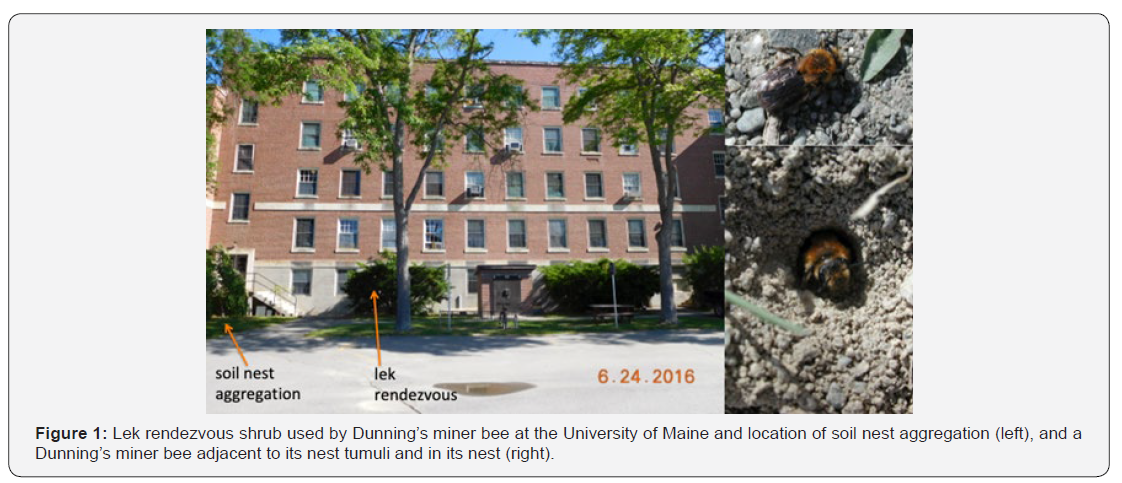
The Gaza Strip (365 km2) is a coastal zone lying in the southern part of the Palestinian coast along the eastern shore of the Mediterranean basin [62]. It is surrounded by the occupied Palestinian Territories from the east and north, Egypt to the south and the Mediterranean to the west. It is composed of five governorates: North Gaza, Gaza, Middle, Khan Younis, and Rafah (Figure 1). The Gaza Strip has a population of about 2 million, mostly refugees from the 1948 Nakba. The population density is about 5,500 inhabitants per square kilometer, making the Gaza Strip one of the most densely populated areas in the world. The Gaza Strip is characterized by its semi-dry Mediterranean climate, which is hot in summer and cold in winter. The average temperatures in the Gaza Strip range from 25 °C in summer to 13 °C in winter. The average annual rainfall is 300 mm. The daily relative humidity fluctuates between 65% and 85% in summer and between 60% and 80% in winter. Sand dunes are the main feature of the western part of the Gaza Strip, while the clay and clayey lands predominate in the eastern part [3,87].
Al-Mawasi Ecosystem
Al-Mawasi ecosystem is a narrow strip of fertile land in the far south-west of the Gaza Strip (in the western part of Khan Younis, Rafah and southern Deir Al-Balah) [88]. The total area of Al- Mawasi area is about 14 km2; having a one kilometer wide and fourteen kilometers long (Figure 2). It represents about 3% of the total area of the Gaza Strip. Al-Mawasi has a semi-dry climate with an annual precipitation of about 250mm. Sand Dunes are the main topographic characteristic feature of Al-Mawasi area, coming as a natural extension of the sand dunes along the Sinai desert of Egypt [88,89]. The ecosystem is very rich in its floristic species as well as agricultural plants that have multiple uses by both local people and wildlife [89,90]. This area is rich in the presence of absorbents (called locally as Thamelas) (Figure 3), which are small wetlands formed naturally as groundwater collection ponds, used locally to irrigate the local crops. Similar to the wetland ecosystem of Wadi Gaza in the middle of the Gaza Strip and the effluent lake of the Beit Lahia wastewater treatment plant in North Gaza, the absorbents of Al-Mawasi ecosystem are significant habitats for aquatic plants, insects; especially mosquitoes, amphibians and aquatic birds (66, 67, 69, 76-78, 91-94). Al-Mawasi ecosystem is one of the most fertile agricultural areas in the Gaza Strip [89]. Unfortunately, Al-Mawasi ecosystem was subject to various violations during the Israeli Occupation era including the establishment of Israeli settlements, extraction of sand, disappearance of ecological habitats, increased groundwater and soil salinities, reduced areas of agriculture, dumping and burial of hazardous chemical wastes, etc. [95,96]. Such violations and habitat alteration and destruction seem to negatively affect the ecology of Al-Mawasi ecosystem as a rural area. Even after the Israeli evacuation from the Gaza Strip in late 2005, the total area of Al-Mawasi was also subject to Palestinian violations including illegal constructions, establishment of wastewater lagoons and sand extraction, thus depleting both ecological habitats and the harsh coastal aquifer [97].
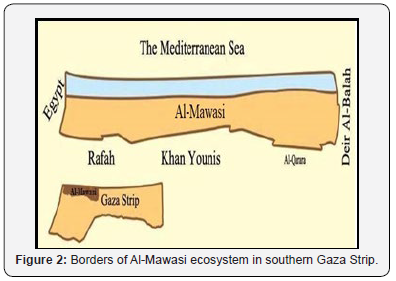
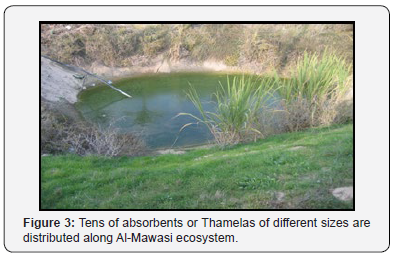
Procedure
The current study was based on continuous direct observations and monitoring of terrestrial vertebrate fauna (mammals, reptiles and amphibians) of Al-Mawasi ecosystem. The survey period covered 10 years extending from the beginning of 2009 to late 2018, though old records of terrestrial vertebrate fauna were considered. Frequent site visits, eco-trips and discussions with local inhabitants and stakeholders were used to determine terrestrial vertebrate fauna of the area. Many tools including binoculars, digital cameras, traps, aquatic nets for amphibian catches and bags were used, when necessary, throughout the investigation process. Many wildlife hunters and local people in the area were good contributors to this work through their provisions to live specimens to the author. Roadkills and dead specimens, encountered at Al- Mawasi ecosystem, were good contributors to the knowledge and identification process of vertebrate fauna. Throughout the study period, many live as well as dead specimens were transferred to the laboratories of the Department of Biology at the Islamic University of Gaza, where the author works, for further taxonomy and preservation. Several available local, regional and international guidebooks have been used in the identification process of mammals, reptiles and amphibians [1,20,40,43,46,98-107].
Photography and data analysis
During the study period, big numbers of photographs concerning the vertebrate fauna of Al-Mawasi ecosystem and other parallel environments have been taken for documentary and confirmation purposes. Photographs were commonly taken by the author himself or by his professional colleagues or even his biology students who were interesting in wildlife monitoring. Statistical data were analyzed using the SPSS (Statistical Package for Social Sciences, Chicago, Illinois). Graphs were plotted using Microsoft Excel 2010.
Results
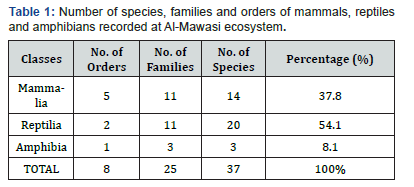
The current study deals with terrestrial vertebrate fauna (mammals, reptiles and amphibians) of Al-Mawasi ecosystem. The findings revealed a considerable diversity of the fauna in question though the area studied is very small (14 km2) and constitutes 3.84% of the total area of the Gaza Strip (365 km2). A total number of 37 species belonging to 25 families and 8 orders of mammals, reptiles and amphibians was recorded (Table 1). The mammalian species constituted 37.8% of the total species recorded, while the reptilian and amphibian species constituted 54.1% and 8.1% respectively of the total species recorded (Figure 4). The details of each class are described as follows:
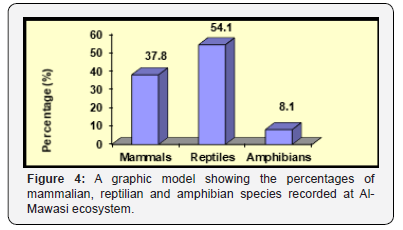
Mammals
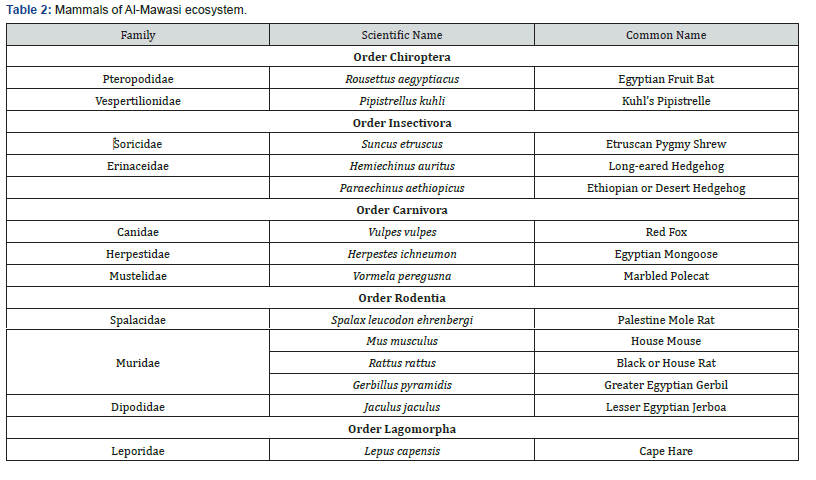
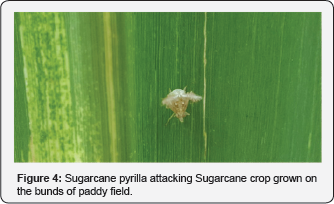
A total number of 14 mammalian species belonging to 11 different families and 5 orders were recorded in Al-Mawasi ecosystem (Table 2), (Figure 5). All mammalian species seemed to be resident in the Gaza Strip environment and mostly found throughout the year. At least, four of the species mentioned in (Table 2) were very rare in the sense that they are rarely seen by the author and the local inhabitants of Al-Mawasi ecosystem. They are the Etruscan Pygmy Shrew (Suncus etruscus), Red Fox (Vulpes vulpes), Marbled Polecat (Vormela peregusna) and Cape Hare (Lepus capensis). The Cape Hare is the only species representing the Order Lagomorpha in Al-Mawasi ecosystem and the Palestinian Territories. Rodentia was by far the biggest order, comprising 5 species; with the majority are agricultural and environmental pests causing harm to agricultural and cereal crops, poultries, public health and other human properties. The Egyptian Fruit Bat (Rousettus aegyptiacus), which is the largest bat species in Palestine, was considered by local inhabitants as a pest, threatening their fruit orchards. In spite of their ecological role, the flesh-eating characteristics of all carnivorous species listed in Table 2 make them unloved by local inhabitants. They claimed that these animals threaten, by their attacks, their poultry animals like chicken, turkeys, pigeons, geese, ducks, rabbits, goats, sheep, etc.
Reptiles
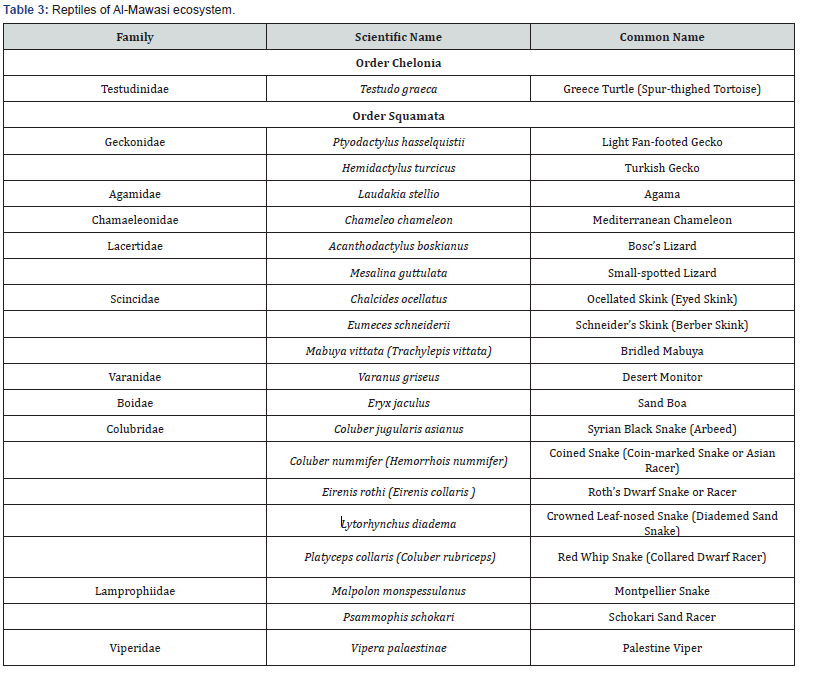
A total number of 20 reptilian species belonging to 11 different families and two orders were recorded in Al-Mawasi ecosystem (Table 3) (Figure 6). Squamata was the biggest order, comprising 19 species (10 lizards and 9 snakes). The Greece Turtle or Spur-thighed Tortoise (Testudo graeca) is the only terrestrial species representing the Order Chelonia in Al-Mawasi ecosystem. All reptilian species are resident and mostly found throughout the year. According to the IUCN Red List, the Greece Turtle is listed as a vulnerable species. Local inhabitants are fond of collecting the juvenile and adult individuals of the species to keep them as pet animals at homes and gardens. As many as 34 individuals were noted by the author to be caged at the zoological gardens or pet shops prevailing in the Gaza Strip. Despite its few numbers, the Desert Monitor (Varanus griseus) was, by far, the biggest lizard species in the Gaza Strip and Al-Mawasi area. It falls under an actual threat because of habitat destruction and intentional killing. The most common species of lizards observed were the Bosc’s Lizard (Acanthodactylus boskianus) and Agama (Laudakia stellio). They were sometimes seen in tens during site visits. Family Colubridae was the biggest among the ophidian species listed in Table 3. Considerable numbers of all snake species recorded in the current study were found to be captured by snake hunters. During site visits, many poisonous and non-poisonous snake species were found to be killed with clear lesions were noted on their heads. In spite of this killing phenomenon, many inhabitants talked much about the ecological benefits of snakes in controlling the vertebrate pests threatening agricultural crops and public health and human possessions or properties. Local inhabitants usually complain from the fear films and the dangerous snakebites attributed mostly to the venomous Palestine Viper (Vipera palaestinae). The Syrian Black Snake or Arbeed (Coluber jugularis asianus) was, by far, the most common and well-known snake species in Al-Mawasi ecosystem.
Amphibians
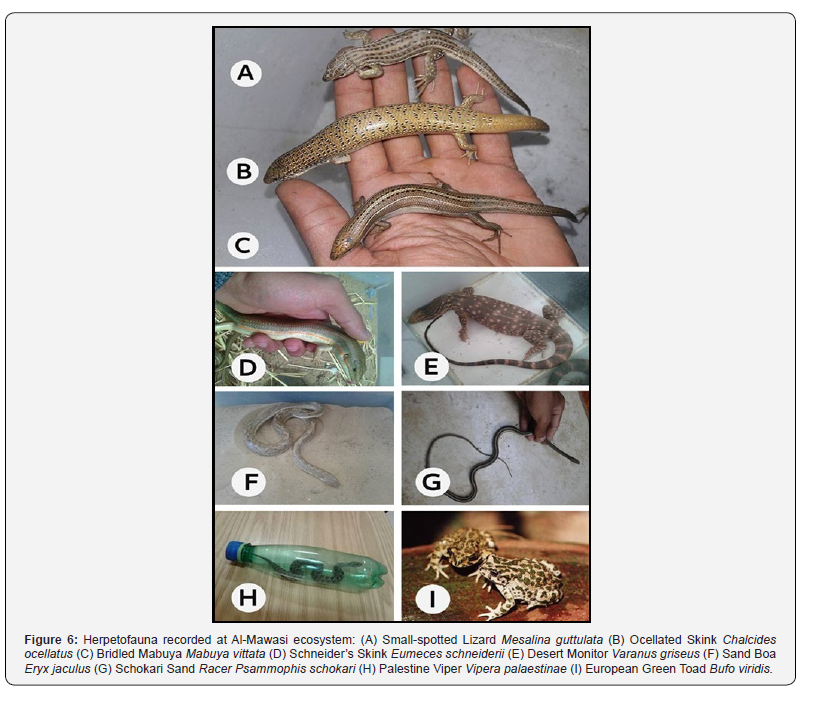
Amphibians are very sensitive to environmental pollution and degradation and as a result, they are considered as good indicators of environmental deterioration worldwide. Three amphibians belonging to three families and one order (Anura) were recorded to inhabit the absorbents (Thamelas), temporary rainwater pools, irrigated canals and agricultural fields of Al-Mawasi ecosystem (Table 4). Like reptilians, all amphibian species, represented here by frogs and toads, are resident and mostly found throughout the year. The Common Toad (Bufo viridis) was far more common than the other two species (Figure 6). Similar to their general status in the Gaza Strip, the three species have declined in Al-Mawasi ecosystem. In spite of their capital role in controlling the populations of harmful insects, local inhabitants were found to complain from the extreme loud noises produced by these frog species.

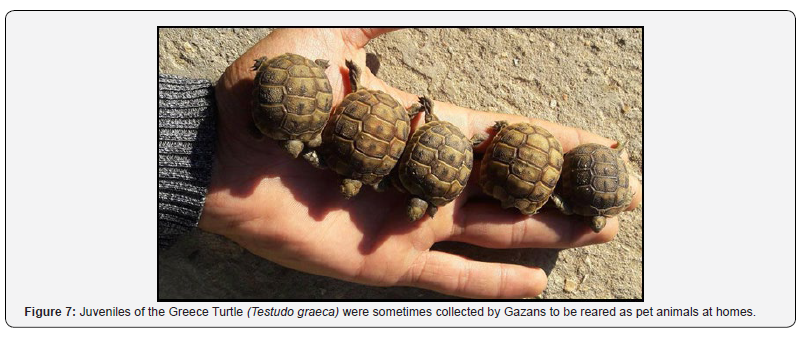
Discussion
Mammals
Palestine is home to more than 100 mammalian species, with bats constituting more than 30 species of these mammals [1]. According to Qumsiyeh [11,14,108], these chiropterans are very diverse and occur in the different ecosystems and habitats of the Palestine and Jordan environments. Although two species of bats (Egyptian Fruit Bat Rousettus aegyptiacus and Kuhl’s Pipistrelle Pipistrellus kuhli) were only recorded throughout the current study, the actual number of bat species seems to exceed the current figure. This could be attributed to the fact that insectivorous bats are nocturnal animals requiring special survey tools that are currently lacking in the Gaza Strip. Most wildlife surveyors, though they are very few, prefer to survey diurnal vertebrate species because of the political, military and socioeconomic circumstances prevailing in the Gaza Strip. It is worth mentioning that the Gaza Strip is a unique area of the world that is subject to frequent blockades, military aggressions and wars imposed by the Israeli occupation since 1967. Moreover, wildlife and ecological studies are new disciplines in the Gaza Strip, starting just with the introduction of the Palestinian National Authority in 1994. The current increasing developmental operations and the heavy use of chemical pesticides occurring in Al-Mawasi ecosystem seem to pose threats on wildlife ecology including bats. Many studies pointed out that bat ecology and diversity in Jordan have been impacted by pesticide application and habitat destruction [17,27].
The Egyptian Fruit Bat (Rousettus aegyptiacus) is of local concern by Gazan famers, including the inhabitants of Al-Mawasi ecosystem, because of its frugivorous feeding and roosting habits on fruit plantations. Although the species is considered locally as an agricultural pest, the economic losses caused by its attacks have never been estimated. In Israel, the Egyptian Fruit Bat was considered an agricultural pest [109] and programs were adopted and applied to combat the species in its feeding and roosting places via the application of mist nets and fumigation techniques. Such control methods were found to negatively impact non-target species including birds and insectivorous bats [110]. According to Korine et al. [111], recent investigations on the local diet of the Egyptian Fruit Bat shed doubts the consideration of the bat as a major agricultural pest in Israel. The Kuhl’s Pipistrelle seems to be the most common insectivorous bat in the Gaza Strip. Such thoughts were supported by Qumsiyeh [1,65], Amer et al. [17] and Abd Rabou et al. [76] who pointed out the commonality of the Kuhl’s Pipistrelle among other bat species near human dwellings.
The current recorded hedgehog species; namely the Longeared Hedgehog (Hemiechinus auritus) and the Ethiopian Hedgehog (Paraechinus aethiopicus) are common nocturnal, insectivorous mammals of the Gaza Strip [67,76]. The European Hedgehog (Erinaceus europaeus), which is found in the West Bank [65] seems to be not present in the Gaza Strip. The recorded hedgehog species were sometimes found killed for no clear reasons in the Gaza Strip. In spite of its rarity, hunting of hedgehogs by Palestinians living in the margins of the Gaza Strip, including very few people in Al- Mawasi ecosystem, for meat consumption was reported [76]. Such killing and hunting of hedgehogs could hurt their populations to low levels that species may go extinct. In comparison, wildlife is generally protected in Israel and the practice of illegal hunting and poaching of wildlife by Thai guest workers seem to have serious deleterious impacts on different wild vertebrate categories, with hedgehog species were not exceptional [53].
The insectivorous Etruscan Pygmy Shrew (Suncus etruscus) recorded in the current study is considered the smallest mammalian worldwide. It seems to have a wide geographical distribution exceeding the limits of the Middle East [1,16,23,43,101-103,112]. The species is rare in the study area as claimed by local inhabitants. It was not previously recorded among the mammals of North Gaza and Wadi Gaza Nature Reserve [75,76], and this could be attributed to its rarity, very small size and maybe because of its new occurrence. Although the Etruscan Pygmy Shrew is known from the Mediterranean parts of the country [103], it has been recently recorded in the Negev Desert, which is very close to the Gaza Strip, in southern Palestine [113, 114]. The Red Fox (Vulpes vulpes), Egyptian Mongoose (Herpestes ichneumon) and Marbled Polecat (Vormela peregusna) were the only three carnivorous mammalian species encountered at Al-Mawasi ecosystem. The Egyptian Mongoose is the commonest among these carnivores. This could be attributed to its medium-sized nature that can exploit the mono-stands of Phragmites australis & Tamarix nilotica plantations prevailing in and around the absorbents that characterize Al-Mawasi ecosystem. Moreover, the presence of poultries and animal husbandries and the diversity of wildlife there promote the occurrence of carnivore animals [115]. This may interpret the tendency of local inhabitants to kill and poison the Egyptian Mongoose, which is known for its attacks to poultries [68,76,116]. The relatively far distance of Al-Mawasi ecosystem from the eastern borders of the Gaza Strip, which is characterized by its relatively high level of biodiversity, makes the number of carnivores limited to the recorded species. Abd Rabou [68] recorded as many as eight carnivore species inhabiting or visiting the Gaza Strip, with the majority of them were recorded in the eastern parts of the Gaza Strip. Many carnivorous species were said to enter the Gaza Strip through gaps in the political fence made by Israel to separate the Gaza Strip from the rest of the Palestinian lands occupied by Israel in 1948. Underground burrows constitute another way for carnivore entrance to the Gaza Strip. The entrance of large and medium- sized mammals, like the Grey Wolf (Canis lupus), into the Gaza Strip is rare and may come as a natural event associated with the bigger home ranges characterizing these mammals [117]. Hunting of different carnivore species, using different trapping means, to be caged and kept at Gaza zoological gardens was and is still an escalating phenomenon [67-70,76]. Poverty, unemployment and the Israeli blockade imposed on two million people living in the Gaza Strip are strong factors enhancing wildlife hunting for different purposes including meat, rearing at homes, fun, game and trade [118]. In a very striking event, two caged specimens of the Egyptian Mongoose were encountered to be exhibited for trade at Al-Yarmouk Market of the Gaza City in the last couple of years [116].
Mounds or soil heaps of the Palestinian Mole-rat (Spalax leucodon ehrenbergi) are quite common in nearly all regions of the Gaza Strip including Al-Mawasi ecosystem and the sand dune-cultivated areas. The animal seems to spend its life building tunnels and underground burrows and almost never going into the open. This could be deducted from the fact that the author was able to identify new soil heaps that never found in the early hours of the day. It is worth mentioning that such mounds are home to different species of arthropods [119] and this means that the Palestinian Mole-rat is a keystone animal in the Palestine environment benefiting the occurrence of other invertebrate species in its mounds. The tunnels of the Palestinian Mole-rat run among roots, tubers and bulbs of plants on which the animal feed [98,120]. The animal is an actual pest to the Palestinians because of its attacks to agricultural plants. As a result, different innovative control means are commonly adopted by farmers to combat the species [76]. The animal is very common in the whole Palestinian Territories including the very rocky habitats [1,79,85]. The other small species of rodents (families Muridae and Dipodidae) of Al-Mawasi ecosystem are agricultural pests, having their own burrows built everywhere in the Gaza Strip. Generally speaking, the rodents of the Gaza Strip form a fraction of what is actually found in the West Bank of Palestine and Jordan [1,50,58,121]. The Indian Crested Porcupine (Hystrix indica), which is the largest rodent in the Gaza Strip, was said by many Palestinians to be present near the eastern borders of the Gaza Strip. Alkon [122] pointed out that the animal was found to dig its own burrows in the Negev Desert highlands which are not far away from the eastern borders of the Gaza Strip. The animal’s quills have been sometimes collected by those people (Personal Communications) and other Palestinians in the West Bank of Palestine [85]. The animal has never been encountered at Al-Mawasi ecosystem as well as the western belt of the Gaza Strip. This could be attributed to the sandy nature of the belt and to the fact that the animal tends to avoid the crowded populated areas characterizing western Gaza Strip. In this context, the Indian Crested Porcupine and the non-indigenous Coypu or Nutria (Myocastor coypus) are two largest rodents inhabiting various ecosystems in Palestine and Jordan [1,123,124]. In a unique and a very rare event, three specimens of the latter were captured together from the Mediterranean coast of the Gaza Strip by fishermen in 1997 [76]. The Cape Hare (Lepus capensis) is the only member of order Lagomorpha inhabiting Palestine [1,65,67,69,70,75,76,81]. Prior to 30-40 years, the animal was common in the Gaza Strip inhabiting various ecosystems including the coastal sand dunes and Al-Mawasi ecosystem. Nowadays, the animal is rarely seen in Al-Mawasi ecosystem, sand dunes and the grape and citrus orchards of western Gaza Strip. Instead, a few numbers are said by local people to inhabit the eastern parts of the Gaza Strip. Hunters usually face difficulties in hunting the Cape Hare because of its rare occurrence due to overhunting and habitat destruction in the Gaza Strip.
Artiodactylous mammals are lacking in Al-Mawasi ecosystem though many Palestinians confirmed the rare occurrence and sometime hunting of two gazelle species in the eastern and northern parts of the Gaza Strip. The Palestine Mountain Gazelle (Gazella gazella) and Dorcas Gazelle (Gazella dorcas), which belong to Bovidae family, were known to enter the Gaza Strip via gaps in the political borders isolating the Gaza Strip from the rest of the Palestinian lands occupied by Israel in 1948. The Dorcas Gazelle is one of the main zoo gazelles in the Gaza Strip [70]. This gazelle along with other zoo artiodactylians was smuggled to Gaza zoological gardens from Egypt through earth tunnels connecting the Egyptian Territories with the Palestinian Territories of the Gaza Strip (2006 – 2013). Such intermittent and rare sights of the gazelles in the Gaza Strip could be attributed to fence effect that lowers the occurrence of large and medium-sized mammals [68-70,76]. Similarly, the Israeli Segregation Wall has negative impacts on wildlife and its free movement in the West Bank of Palestine [125]. In addition, gazelles are among the declining vertebrate animals in Palestine because of habitat destruction, hunting and perhaps the ongoing global climate change [79,85]. Malignant foot and mouth disease in Mountain Gazelles caused considerable losses of the animal in Israel in 1980’s [126,127].
Reptiles
All reptilian species recorded in Al-Mawasi ecosystem are of Mediterranean affinities and most of them were recorded in other Palestinian and Jordanian studies [13,20,29,59,67,75,77, 82,85,128]. The arid to semi-arid environment of the Gaza Strip seems to attract more species of reptilians exceeding the species recorded in Al-Mawasi area. This is simply because of habitat diversity and the great possibility of some recruits coming freely from Sinai Peninsula (Egypt) and the Palestinian lands of 1948. Previous studies on reptiles [66,67,75,77] recorded species that were not recorded in the current study. The Greece Turtle or Spurtoughed Tortoise (Testudo graeca) is a chelonian species having a wide distribution range within the Gaza Strip and the Middle East. In the Gaza Strip, the species faces actual threats because of its ease hunting, pet trade and continuous human disturbance to its ecological habitats. Many people were found to rear juveniles and adults of the species at their home as pet animals (Figure 7). This is simply because the species is completely herbivorous, feeding on a wide range of plant materials and residuals [100,129], which are commonly found at the Palestinians’ homes.
Although Greece Turtle is widespread, it is classified as Vulnerable on the IUCN Red List. Modern farming and overgrazing are main threatening factors contributing to habitat destruction of the species. Predation of wild animals on the Greece Turtle in the Gaza Strip is not well known and is not fully understood because of the species’ carapace. However, the Common Buzzard (Buteo buteo) was observed in Iran to drop an adult tortoise from high elevations in a mountainous area in order to break its carapace and to feed later on its flesh [130]. Bayley & Highfield [131], Turkozan & Olgum [132], Sadeghi & Torki [133] pointed out that the species is often threatened by anthropogenic activities such as pet trade, hunting for food or habitat destruction, modification and alteration. In the Gaza Strip, the meat of this tortoise is generally not consumed (Personal Communication). Lizards are very diverse in the Palestine and Jordan environments; they occupy various ecosystems and habitats. They are very characteristic to the arid to semi-arid nature of the two countries. The habitats of the Gaza Strip are not completely analogous to those of Palestine and Jordan and as a result, the ten species of lizards recorded at Al-Mawasi ecosystem seem to constitute a part of what the two countries actually harbor? This was evident from the relatively high number of lizards recorded at the two countries in question [13,16,20,29,38,42,81,85,134, 135]. The Desert Monitor (Varanus griseus) is the largest among the lizards of the Gaza Strip [77]. It inhabits the sand dunes of Al-Mawasi ecosystem though it is found in different varieties of substrates in the Gaza Strip [77]. Stanner & Mendlessohn [136,137] noted that the species inhabits sand dunes and is not averse to areas of human activity including rubbish dumps and building sites in Israel. Although the species is a common zoo animal in most zoological gardens of the Gaza Strip, it is highly endangered due to its hunting and intentional killing by farmers and local people. Some people claimed that they usually kill the species because of its fearful size and expected predation on poultries and avian eggs. These claims were proved by Stanner & Mendlessohn [138] in Israel, Tilbury [139] in Arabia & Kumlutas [140] in Turkey who confirmed the feeding of the Desert Monitor on toads, lizards, snakes, tortoises, birds and mammals in addition to the eggs of many wild and domesticated animals.
Seven species of snakes representing four families have been recorded in Al-Mawasi ecosystem. The Sand Boa (Eryx jaculus) seems to be the only member representing the family Boidae in the Gaza Strip [76] and the West Bank [82]. The species has a wide distribution in Middle East and North African countries [106,141,142] and in Europe as well [143,144]. Like other snakes of the Gaza Strip, the Sand Boa is a predator of small mammals, lizards, birds and insects [141,145]. As its name dictates, the species spends much of its life burrowed under the sandy soil in which they live, and this was what the author observed. Hence, Al-Mawasi ecosystem with its sand dune topography is a very suitable habitat for this kind species. As far as the Colubridae family is concerned, it was, by far, the biggest of the recorded families as it was represented by five species. In both Wadi Gaza and Wadi Al-Quff of Palestine, the Colubridae constituted the higher number of species [65,77]. Both the Syrian Black Snake (Coluber jugularis asianus) and the Coined Snake (Coluber nummifer) are very common in the Palestinian and Jordanian Territories [16,19,82,85,104,107]. The Syrian Black Snake, which is locally known as Arbeed, is by far, one of the most common snakes in the Palestinian environment to the extent that two families in the Gaza Strip have been named with the local name of this reptile; Al-Arbeed and Al-Arabeed (plural of Arbeed). According to Abd Rabou et al. [77], the snake may exceed two meter in its length. Such a length of a black creature usually imposes fear among the Palestinian population, especially women and children who may face the snake in agricultural fields or among the bushes. The snake is not poisonous from a health point of view and its environmental role in the fight against rodents and other unwanted animals is highly appreciated and respected by most farmers and the scientific parties of the Gaza Strip. However, killing of poisonous and non-poisonous snakes by local people is a common phenomenon in the Palestinian Territories. Most people cannot discriminate between poisonous and non-poisonous snakes. The author encountered tens of killing cases of snakes of different species in Al-Mawasi ecosystem and other areas of the Gaza Strip. In many occasions, the killed snakes were seen thrown in the middle of rural roads or hung on the fences of agricultural orchards and farms around the Gaza Strip.
Special concern is locally and continuously paid to the Palestine Viper [146], which is endemic to Palestine and its neighboring countries. The species is, by far, the most venomous snake in both Palestine and Jordan. Each of the two countries is home to more or less of 40 snakes, with one-fourth of these snakes are poison ous [34,104,107,146-148]. Most of snake bites in these countries are commonly attributed to the Palestine Viper and uncommonly to the Painted Saw-scaled Viper or Painted Carpet Viper (Echis coloratus) as pointed out by many studies [34,69,77,74,82,84,85, 91,104,146,149]. The Palestine Viper is currently one of the most preserved or caged biological specimens at the Departments of Biology of local universities and local zoological gardens. The species is well known by most Palestinians to the extent that they termed it as the “Palestine Za’ara Hayaa”. In summer season, the snake exhibits its maximum activity and breeding biology as pointed out by Abd Rabou [146]. Envenomation by the Palestine Viper is not restricted to humans. It was also reported in domestic animals including dogs, cats, horses, sheep, goats, chickens, rabbits, pigeons and cows [84] as many people in Al-Mawasi and other areas of the Gaza Strip claimed. In conclusion, the medical reports of Palestine indicated that more than 90% of snake bites have been attributed to the Palestine Viper. Accordingly, it was considered as the most dangerous and poisonous snake in the Palestine environment [34,84,146,149].
Amphibians
The three species of amphibians recorded at Al-Mawasi ecosystem are the same of that prevailing in the whole Gaza Strip [77]. They are all anurans (tailless amphibians), represented by frogs and toads. They inhabit the absorbents (Thamelas), agricultural lands, irrigated schemes, rain pools of Al-Mawasi ecosystem. Such fresh aquatic and riparian habitats are known to attract amphibians and other wildlife species [150]. However, amphibians cannot tolerate the high salt content of sea water and as a result, none of them are strictly marine [100,151]. The anurans of the Gaza Strip, like those inhabiting the various ecosystems worldwide, are often used as indicators of environmental conditions because of their physiology and unique biphasic life cycles as pointed out by Henry [152]. Decline or loss of amphibian species can give a sign of an early warning of global change [153]. Such declines in amphibian population in Al-Mawasi ecosystem are expected because of habitat modification and destruction represented there by drainage of absorbents, heavy application of pesticides, salinization of groundwater and soil resources and the ongoing global climate change catastrophe. It is worth mentioning that water resources of the Gaza Strip, including Al-Mawasi ecosystem, are subject since decades to groundwater overpumping, pollution and seawater intrusion [3,96]. The drastic decrease and even extinction of amphibian species and populations, including anurans, throughout the world has increased during the last decades. Such a decrease has been attributed to global climate change, the rise in ultraviolet radiation, diseases, habitat loss and destruction, habitat pollution, unsustainable use, invasive or alien species [154-156]. The apparent absence of salamanders (order Urodela) in the Gaza Strip could be attributed to the fact that the average annual rainfall in the Gaza Strip is 300 mm [3]. It has been thought that the occurrence of salamanders in north Palestine may be partially and much related to rainfall levels exceeding the threshold of 500 mm annually. According to Disi [104], the Banded Newt (Triturus vittatus) is commonly encountered in the Mediterranean biotope having an annual rainfall of 400-500 mm or more; conditions characterizing the upper parts of Palestine, but not the lower parts where the arid to semi-arid Gaza Strip is located [157-161].
References
- Qumsiyeh MB (1996) Mammals of the Holy Land. Texas Tech. University Press, USA.
- Palestinian Environment Authority – PEnA (1999) National Biodiversity Strategy and Action Plan for Palestine. Palestinian Environment Authority, April 1999, Hebron, Palestine, pp. 232.
- UNEP (2003) Desk study on the environment in the Occupied Palestinian Territories. United Nations Environment Program, Nairobi, Kenya, pp. 188.
- Environment Quality Authority – EQA (2006) Third national report on biodiversity conservation: Third national report on the implementation of Article 6 of the Convention on Biological Diversity. Environment Quality Authority, Palestinian National Authority, Palestine. p. 74.
- Perlman Y, Meyrav J (2009) Checklist of the birds of Israel. Society for the Protection of Nature in Israel p. 29.
- Atallah SI (1967) A collection of mammals from El-Jafr, southern Jordan. Säugetierkundliche Mitteilungen 32: 307-309.
- Atallah SI (1977) Mammals of the Eastern Mediterranean: Their ecology, systematics and zoogeographical relationships. Säugetierkundliche Mitteilungen 25: 241-320.
- Atallah SI (1978) Mammals of the Eastern Mediterranean: Their ecology, systematics and zoogeographical relationships. Säugetierkundliche Mitteilungen 26: 1-50.
- Disi AM (1985) Environmental factors affecting snake distribution in Jordan. In: Proceedings of the Symposium on the Fauna and Zoogeography of the Middle East, Mainz, pp. 296-310.
- Gasperetti J, Harrison D, Büttiker W (1985) The Carnivora of Arabia. Fauna of Saudi Arabia 7: 397-461.
- Qumsiyeh MB (1985) Bats of Egypt. (1st edn), Texas Tech University Press, Lubbock, pp. 102.
- Amr ZS, Woodburry S, Disi AM (1987) On a collection of mammals from Jordan. Dirasat 14: 131-136.
- Amr ZS, Al-Oran R, Disi AM (1994): Reptiles of southern Jordan. The Snake 26: 41-49.
- Qumsiyeh MB, Amr ZS, Budairi AM (1996) Status and conservation of Artiodactylia (Mammalia) in Jordan. Mammalia 60(3): 417-430.
- Amr ZS, Al-Melhim WN, Yousef MA (1997) Mammal remains from pellets of the Eagle Owl, Bubo bubo, from Azraq Nature Reserve, Jordan. Zoology in the Middle East 14: 5-10.
- Abu Baker M, Amr Z (2004) The rodents (Mammalia: Rodentia) of Wadi Ramm, southern Jordan: New records and notes on distribution. Arab Gulf Journal of Scientific Research 22: 9-20.
- Amr ZS, Abu Baker MA, Qumsiyeh MB (2006) Bat diversity and conservation in Jordan. Turkish Journal of Zoology 30: 235-244.
- Amr ZS, Disi A (1988a) Jordanian Mammals Acquired by the Jordan University Natural History Museum. Publication of the University of Jordan, Amman 32.
- Amr ZS, Disi AM (1988b) Diet of some snakes from Jordan. Amphibia-Reptilia 19: 436-439.
- Amr ZS, Disi AM (2011) Systematics, distribution and ecology of the snakes of Jordan. Vertebrate Zoology 61(2): 179-266.
- Gasperetti J (1988) Snakes of Arabia. Fauna Saudi Arabia 9: 169-450.
- Mendelsson H, Yom-Tov Y (1988) Changes of the distribution and abundance of vertebrates during the 20th Century in Israel. In: The Zoogeography of Israel pp. 515-548.
- Nader IA (1990) Checklist of the mammals of Arabia. Fauna of Saudi Arabia 11: 329-381.
- Nader IA (1996) Distribution and status of predators in Saudi Arabia. Journal of Wildlife Research 1: 210-214.
- Hatough-Bouran A, Disi AM (1991) History, distribution, and conservation, of large mammals and their habitats in Jordan. Environmental Conservation 18(1): 19-32.
- Qumsiyeh MB, Amr ZS, Shafei D (1993) The status and conservation of carnivores in Jordan. Mammalia 57(1): 55-62.
- Qumsiyeh MB, Amr ZS, Al-Oran RM (1998) Further records of bats from Jordan and a synopsis. Turkish Journal of Zoology 22: 277-284.
- Werner YL (1988) Herpetofaunal survey of Israel (1950-85), with comments on Sinai and Jordan and on zoogeographical heterogeneity. Monographiae Biologicae 62: 355-388.
- Al-Oran RM, Disi A M, Al-Melhim WN, Amr Z (1997) Reptiles of Wadi Araba. Muta, 12: 45-67.
- Al-Jumaily MM (1998) Review of the mammals of the Republic of Yemen. Fauna of the Saudi Arabia 17: 477-502.
- Budak A, Tok CV, Mermer A (1998) A report on reptiles collected from Kumluca-Kalkan, Turkey. Turkish Journal of Zoology 22: 185-189.
- Disi AM, Amr ZS (2010) Morphometrics, distribution and ecology of the amphibians in Jordan. Vertebrate Zoology 60: 147-162.
- Carmel Y, Safriel U (1998) Habitat use by bats in a Mediterranean ecosystem in Israel: Conservation implications. Biological Conservation 84(3): 245-250.
- Kochva E (1998) Venomous snakes of Israel: Ecology and snakebite. Public Health Review 26(3): 209-232.
- Ozkurt S, Sozen M, Yigit N, Colak, E (1998) Notes on distributional records and some characteristics of five carnivore species (Mammalia, Carnivora) in Turkey. Turkish Journal of Zoology 22: 285-288.
- Benda P, Sádlová J (1999) New records of small mammals (Insectivora, Chiroptera, Rodentia, Hyracoidea) from Jordan. Casopis Národního muzea, Rada prirodovedná 166: 25-56.
- Degani G, Kalpan D (1999) Distribution of amphibian larvae in Israel habitats with changeable water availability. Hydobiologia 405: 49-56.
- Disi AM, Hatough-Bouran A (1999) Biodiversity of the terrestrial vertebrate fauna of Petra (Jordan). Časopis Národního Muzea, Řada Přírodovědecká 168: 83-98.
- Disi AM, Amr ZS, Martens H (2004) On a collection of amphibians and reptiles made by J. Klapperich in Jordan. Herpetozoa 16(3/4): 141-150.
- Disi AM, Modry D, Necas P, Rifai L (2011) Amphibians and Reptiles of the Hashemite Kingdom of Jordan: An Atlas and Field Guide, Frankfurt, pp. 408.
- Sinsch U, Schneider H (1999) Taxonomic reassessment of Middle Eastern water frogs: Morphological variation among populations considered as Rana ridibunda, R. bedriagae or R. levantina. Journal of Zoological Systematics and Evolutionary Research 37: 56-62.
- Al-Oran RM (2000) Notable herpetological records from Central and Southern Jordan. Zoology in the Middle East 21: 31-36.
- Amr ZS (2000) Jordan country study on biological diversity: Mammals of Jordan. United Nations Environment Program, Amman, 100.
- Amr Z (2008) Biodiversity of reptiles and mammals in the Eastern Desert. In: Jordan’s Arid Badia: Deepening our Understanding. Smith Gordon & Co. UK, pp. 449.
- Amr ZS (2011) The history of herpetology in Western Asia. Russian Journal of Herpetology 18: 119-129.
- Amr Z (2012) Mammals of Jordan, (2nd edn), Al Rai Press. Amman, Jordan, pp. 308.
- Baran I, Kumlutas Y, Olgun K, Ilgaz C, Kaska Y (2001) The herpetofauna of the vicinity of Silifke. Turkish Journal of Zoology 25: 245-249.
- Bunaian F, Hatough-Bouran A, Ababneh D, Mashaqbeh S, Yousef M, et al. (2001) The carnivores of the northeastern Badia, Jordan. Turkish Journal of Zoology 25: 19-25.
- Hraoui-Bloquet S, Sadek RA, Sindaco R, Venchi A (2002) The herpetofauna of Lebanon: New data on distribution. Zoology in the Middle East 27: 35-46.
- Abu Baker M, Amr Z (2003) Rodent diversity in the Northeastern Desert of Jordan, with special reference on the ecology of Gerbillus cheesmani. (Mammalia: Rodentia). Casopis Národního Muzea, Rada prirodovedná 172: 141-152.
- Albayrak I (2003) The bats of the Eastern Black Sea region in Turkey (Mammalia: Chiroptera). Turkish Journal of Zoology 27: 269-273.
- Al-Sorkhy M, Amr Z (2003) Platyhelminth parasites of some Amphibians in Jordan. Turkish Journal of Zoology27(2): 89-93.
- Yom-Tov Y (2003) Poaching of Israeli wildlife by guest workers. Biological Conservation 110: 11-20.
- Abu Baker M, Qarqaz M, Rifai L, Hamidan N, Al-Omari K, et al. (2004) Results of herpetofaunal inventory of Wadi Ramm Protected Area, with notes on some relict species. Russian Journal of Herpetology 11: 1-5.
- Masseti M (2004) Artiodactyls of Syria. Zoology in the Middle East 33: 139-148.
- Masseti M (2009) Carnivores of Syria. In: Neubert, Animal diversity in the Middle East. Aqaba, Jordan, 31: 229-252.
- Masseti M (2010) The mammals of the Farasan archipelago, Saudi Arabia. Turkish Journal of Zoology 34: 359-365.
- Modrý D, Rifai L, Abu Baker M, Amr Z (2004) Amphibians and reptiles of the Hashemite Kingdom of Jordan. Denisia 14(2): 407-420.
- Damhoureyeh SA, Qarqaz MA, Abu Baker M, Hmidan N, Eid E, et al. (2009) Reptiles and amphibians in Dibbeen Nature Reserve, Jordan. Vertebrate Zoology 59(2): 169-177.
- Eid E, Al Hasani I, Al Share T, Abed O, Amr Z (2011) Animal trade in Amman local market, Jordan. Jordan Journal of Biological Sciences 4: 101-108.
- Aloufi A, Eid E (2014) Conservation perspectives of illegal animal trade at markets in Tabuk, Saudi Arabia. OBER 26(2): 77-80.
- Eid E, Handal R (2018) Illegal hunting in Jordan: Using social media to assess impacts on wildlife. Oryx 52(4): 730-735.
- Paray BA, Al-Sadoon MK (2018) A survey of mammal diversity in the Turaif Province, Kingdom of Saudi Arabia. Saudi Journal of Biological Sciences 25: 604-608.
- Escoriza D, Ben Hassine J (2019) Amphibians of North Africa, (1st edn). Academic Press pp. 350.
- Qumsiyeh MB (2016) Fauna of Wadi Al-Quff Protected Area: Amphibians, reptiles and mammals. Jordan Journal of Natural History 3: 70-79.
- MedWetCoast (2002) Management plan: Wadi Gaza. Project for the Conservation of Wetland and Coastal Ecosystems in the Mediterranean Region – MedWetCoast pp. 171.
- Abd Rabou AN (2005) An ecological survey and assessment of Wadi Gaza Nature Reserve, Gaza Strip – Palestine, with particular emphasis on wildlife.
- Abd Rabou AN (2009) On the occurrence of some carnivores in the Gaza Strip, Palestine (Mammalia: Carnivora). Zoology in the Middle East 46: 109-112.
- Abd Rabou AN (2011a) On the ecology of Wadi Gaza, Gaza Strip: Survey and assessment. LAP Lambert Academic Publishing, Germany, pp. 304.
- Abd Rabou AN (2011b) The Palestinian mammalian fauna acquired by the zoological gardens in the Gaza Strip. Nusantara Bioscience 3(2): 92-101.
- Abd Rabou AN (2011c) Notes on some Palestinian bird fauna existing in the zoological gardens of the Gaza Strip. American-Eurasian Journal of Agricultural & Environmental Sciences 11(2): 159-172.
- Abd Rabou AN (2019a) Bird fauna encountered at the main campus of the Islamic University of Gaza, Gaza City, Palestine. Biodiversitas 20(2): 604-614.
- Abd Rabou AN (2019b) Ornithofauna prevailing at Al-Mawasi ecosystem of the Gaza Strip, Palestine. Open Journal of Ecology.
- Abd Rabou AN (2019c) Threats facing the archaeological sites and buildings in the Gaza Strip, Palestine. The 4thInternational Conference on Rehabilitation of Historic Sites and Buildings within the Modern Requirements.
- Yassin MM, Abd Rabou AN, Al-Agha MR (2006) Preliminary survey of terrestrial vertebrate fauna and people’s awareness towards wildlife in the Northern Governorate of the Gaza Strip. Al-Azhar Bulletin of Science: Zoology & Botany 17(1): 17-41.
- Abd Rabou AN, Yassin MM, Al-Agha MR, Hamad DM, Ali, AS (2007a) Wild mammals in the Gaza Strip, with particular reference to Wadi Gaza. The Islamic University Journal (Series of Natural Studies and Engineering) 15(1): 87-109.
- Abd Rabou AN, Yassin MM, Al-Agha MR, Hamad DM, Ali, AS (2007b) The herpetofauna of the Gaza Strip with particular emphasis on the vicinity of Wadi Gaza. The Islamic University Journal (Series of Natural Studies and Engineering) 15(1): 111-135.
- Abd Rabou AN, Yassin MM, Al-Agha MR, Hamad DM and Ali AS (2007c) The avifauna of Wadi Gaza Nature Reserve, Gaza Strip - Palestine. The Islamic University Journal (Series of Natural Studies and Engineering) 15(1): 39-85.
- Qumsiyeh MB, Zavala SS, Amr ZS (2014) Decline in Vertebrate Biodiversity in Bethlehem, Palestine. Jordan Journal of Biological Sciences 7(2): 101-107.
- Salman I, Salsaa M, Qumsiyeh MB (2014) Distribution and cytogenetics of amphibians from the occupied Palestinian territories (West Bank of Jordan). Jordan Natural of History Journal 1(1): 86-98.
- Albaba I (2016a) The terrestrial mammals of Palestine: A preliminary checklist. International Journal of Fauna and Biological Studies 3(4): 28-35.
- Albaba I (2016b) The herpetofauna of Palestine: A preliminary checklist. Journal of Entomology and Zoology Studies 4(4): 123-128.
- Albaba I (2017a) Surveying wildlife roadkills in the West Bank Governorates – Palestine, Journal of Entomology and Zoology Studies 5(4): 910-913.
- Albaba IM, (2017b) Venomous snakes and envenomation in Palestine. Journal of Entomology and Zoology Studies 5(2): 493-495.
- Handal EN, Amr ZS, Qumsiyeh MB (2016) Some records of reptiles from the Palestinian Territories. Russian Journal of Herpetology 23: 261-270.
- Khalilieh A (2016) Avifaunal baseline assessment of Wadi Al-Quff protected area and its vicinity, Hebron, Palestine. Jordan Journal of Natural History 3: 58-69.
- Euroconsult, IWACO (1994) Gaza environmental profile Inventory of resources. Palestinian Environmental Protection Authority, Gaza Strip-Palestine, p. 60.
- Zourb A (2013) Strategies for the development of coastal areas - Case study: Al-Mawasi area in Khan Younis and Rafah Governorates, Palestine, pp. 283.
- Palestine Hydrology Group – PHG (2008) Mawasi land use water agriculture practices environmental challenges and perspective for future development, Gaza Strip, Palestine, p. 45.
- Al-Quds Association for Al-Mawasi Development (2017) Guide for natural wild plants in Al-Mawasi coastal area, Gaza Strip. Al-Quds Association for Al-Mawasi Development, Al-Mawasi, Gaza Strip, Palestine, p. 77.
- Abd Rabou AN (2011d) Environmental impacts associated with the Beit Lahia wastewater treatment plant, North Gaza Strip, Palestine. Middle-East Journal of Scientific Research 7(5): 746-757.
- Abd Rabou AN, Yassin MM, Al-Agha MR, Ali AS, Hamad DM (2007e) Aspects of inhabitants' ecological knowledge on Wadi Gaza. International Conference Energy and Environmental Protection in Sustainable Development.
- Abd Rabou AN, Yassin MM, Al-Agha MR, Madi MI, Al-Wali MM, et al. (2008a) Notes on some common flora and its uses in Wadi Gaza, Gaza Strip. The Islamic University Journal 16(1): 31-63.
- Abd Rabou AN, Yassin MM, Sharif FA, Al-Agha MR, Abu Daher KS, et al. (2008b) Inhabitants' knowledge on mosquito proliferation and control in the wetland ecosystem of Wadi Gaza, Gaza Strip, Palestine. The Islamic University Journal 16(2): 41-61.
- Swisa S (2003) Al-Mawasi, Gaza Strip: Impossible life in an isolated enclave. B’Tselem – The Israeli Information Center for Human Rights in the Occupied Territories.
- Palestine Center for Human Rights – PCHR (2004) A report on life under occupation in Al-Mawasi area in the Gaza Strip. Series Study p. 32-141.
- Al-Saud MM (2018) The effect of construction on feeding the groundwater reservoir in Al-Mawasi area in the Gaza Strip. Gaza: Converting Crises into Opportunities, Disaster and Crisis Management, (1st edn), pp. 183-193.
- Boitani L, Bartoli S (1983) Simon and Schuster’s guide to mammals. Simon and Schuster Inc pp. 511.
- Gross C (1987) Mammals of the Southern Gulf. Arabian Heritage Series, Motivate Publishing, Dubai, United Arab Emirates, p. 79.
- Capula M (1989) Simon and Schuster’s guide to reptiles and amphibians of the world. Simon and Schuster Inc pp. 256.
- Harrison DL, Bates PJJ (1991) The mammals of Arabia. Harrison Zoological Museum, Kent, England, pp. 354.
- Breen JF (1994) Encyclopedia of reptiles and amphibians. T F H Publications, New Jersey, USA, pp. 576.
- Mendelsson H, Yom-Tov Y (1999) Mammalia of Israel. Israel Academy of Sciences and humanities, Jerusalem.
- Disi AM (2002) Jordan country study on biological diversity: The herpetofauna of Jordan. The General Corporation for the Environment Protection. The Hashemite Kingdom of Jordan pp. 288.
- Hoath R (2003) A field guide to the mammals of Egypt. The American University in Cairo Press, Egypt, pp. 234.
- Baha El Din S (2006) A guide to the reptiles and amphibians of Egypt. The American University in Cairo Press, Egypt, pp. 381.
- Bar A, Haimovitch G (2012) A field guide to reptiles and amphibians of Israel. Pazbar LTD, Jerusalem, pp 246.
- Benda P, Lučan RK, Obuch J, Reiter A, Andreas M, et al. (2010) Bats (Mammalia: Chiroptera) of the Eastern Mediterranean and Middle East. Part 8. Bats of Jordan: Fauna, ecology, echolocation, ectoparasites. Acta Societas Zoologicae Bohemicae 74: 185–353.
- Moran S, Keidar H (1993) Checklist of vertebrate damage to agriculture in Israel. Crop Protection, 12: 171-182.
- Makin D, Mendelssohn H (1987) Israel wipes out its bats. Ecologist 16: 1-2.
- orine C, Izhaki I, Arad Z (1999) Is the Egyptian fruit-bat Rousettus aegyptiacus a pest in Israel? An analysis of the bat's diet and implications for its conservation. Biological Conservation 88: 301-306.
- Kock D, Nader I (1983) Pygmy Shrew and rodents from the Near East (Mammalia: Soricidae, Rodentia). Senckenbergiana Biologica 64: 13-23.
- Afik D (1996) New record of the Etruscan Shrew Suncus etruscus in the central Negev Desert, Israel. Israel Journal of Zoology 42(3): 293-294.
- Shenbrot G, Krasnov B (1997) Additional records of two small mammalian species in the central Negev. Israel Journal of Zoology 43(3): 299-300.
- Geffen E, Hefner R, MacDonald DW, Ucko M (1992) Diet and foraging behavior of Blanford’s Foxes, Vulpes cana, in Israel. Journal of Mammalogy 73: 395-402.
- Abd Rabou AN (2019d) On the occurrence, ecology and risks of the Egyptian Mongoose (Herpestes ichneumon Linnaeus, 1758) in the Gaza Strip – Palestine. Agricultural Research & Technology: Open Access Journal.
- Afik D (1983) Movements of a radio-collared Wolf (Canis lupus pallipes) in the Negev highlands, Israel. Israel Journal of Zoology 32: 138-146.
- Abd Rabou AN (2009b) The Zionist siege and its environmental consequences in the Gaza Strip. Palestine… 61 years after Nakba 911-933.
- Pavlícek T, Chikatunov V, Nevo E (2005) Arthropods in the mounds of mole rats, Spalax ehrenbergi superspecies, in Israel. Ecologia Mediterranea 31(1): 5-13.
- Nevo E (1961) Observations on the Israeli populations of the Mole Rat, Spalax ehrenbergi Nehring 1898. Mammalia 25: 127.
- Hatough-Bouran A (1990) The burrowing habits of desert rodents Jaculus jaculus and Gerbillus dasyurus in the Shawmari Reserve in Jordan. Mammalia 54: 341-359.
- Alkon PU (1999) Microhabitat to landscape impacts: Crested Porcupine digs in the Negev Desert highlands. Journal of Arid Environments 41: 183-202.
- Roll U, Dayan T, Simberloff D (2008) Non-indigenous terrestrial vertebrates in Israel and adjacent areas. Biological Invasions 10: 659-672.
- Khoury F, Amr Z, Hamidan N, Hassani IA, Mir S, et al. (2012) Some introduced vertebrate species to the Hashemite Kingdom of Jordan. Vertebrate Zoology 62: 435-451.
- Abdallah T, Swaileh K (2011) Effects of the Israeli Segregation Wall on biodiversity and environmentally sustainable development in the West Bank, Palestine. International Journal of Environmental Studies 68: 543-555.
- Shimshony A, Orgad U, Baharav D, Prudovsky S, Yakobson B, et al. (1986) Malignant foot and mouth disease in Mountain Gazelles. Veterinary Records 119: 175-176.
- Baharav D (1988) Mountain gazelle management in northern Israel in relation to wildlife disease control. Revue Scientifique Et Technique De L’Office International Des Epizooties 7(4): 925-927.
- Qumsiyeh MB, Khalilieh A, Albaradeiya IM, Al-Shaikh B (2016) Biodiversity conservation of Wadi Al-Quff protected area (central Palestine): Challenges and opportunities. Jordan Journal of Natural History 3: 2-24.
- El-Mouden EH, Slimani T, Ben Kaddour K, Lagarde F, Ouhammou A, et al. (2006) Testudo graeca graeca feeding ecology in an arid and overgrazed zone in Morocco. Journal of Arid Environments 64: 422-435.
- Rezazadeh E, Alucheh RM, Kami HG (2014) A preliminary study on the Mediterranean Spur-thighed Tortoise Testudo graeca Linnaeus, 1758 from northwestern Iran. Herpetology 7: 127-133.
- Bayley JR, Highfield AC (1996) Observations on ecological changes threatening a population of Testudo graeca graeca in the Souss Valley, Southern Morocco. Chelonian Conservation and Biology 2: 36-42.
- Turkozan O, Olgun K (2005) A preliminary survey of Testudo graeca Linnaeus 1758 specimens from central Anatolia, Turkey. Turkish Journal of Zoology 29: 255-262.
- Sadeghi R, Torki F (2012) Notes on reproduction and conservation of Testudo graeca ibera Pallas 1814 (Reptilia: Testudinidae) in Zagros, western Iran. Amphibian and Reptile Conservation 5(1): 98-104.
- Sivan N, Werner YL (1992) Survey of the reptiles of the Golan Plateau and Mt. Hermon, Israel. Israel Journal of Zoology 37: 193-211.
- Disi AM, Amr ZS (1998) Distribution and ecology of lizards in Jordan (Reptilia: Sauria). In: Contribution to a “Herpetologia Arabica”. Faunistische Abhandlungen Staatliches Museum für Tierkunde Dresden 43-66.
- Stanner M, Mendlessohn H (1983) Activity patterns and habit utilizations of Varanus griseus in the sand dunes south of Holon, Israel. Israel Journal of Zoology 32: 164.
- Stanner M, Mendlessohn H (1987) Sex ratios, population density and home range of Varanus griseus in the southern coastal range of Israel. Amphibia–Reptilia 8(2): 153-163.
- Stanner M, Mendlessohn H (1986) The diet of Varanus griseus in the southern coastal plain of Israel. Israel Journal of Zoology 34(1/2): 67-75.
- Tilbury CR (1988) An annotated checklist of the commoner reptiles occurring around Riyadh, Kingdom of Saudi Arabia. The Journal of the Herpetological Association of Africa 34: 25-34.
- Kumlutas Y, Oz M, Durmus H, Tunc MR, Ozdemir A, et al. (2004) On some lizard species of the western Taurus range. Turkish Journal of Zoology 28: 225-236.
- Schleich HH, Kastle W, Kabish K (1996) Amphibians and reptiles of North Africa: Biology, systematics, field guide. Koeltz Scientific Books, Koenigstein, Germany pp. 630.
- Al-Sadoon MK, Al-Otaibi FS (2014) Ecology of the sand boa, Eryx jayakari in Riyadh 168 Region of Saudi Arabia. Saudi Journal of Biological Sciences 21: 391-393.
- Insacco G, Spadola F, Russotto S, Scaravelli D (2015) Eryx jaculus (Linnaeus, 1758): A new species for the Italian herpetofauna (Squamata: Erycidae). Acta Herpetologica 10(2): 149-153.
- Faraone FB, Russotto S, Barra SA, Chiara R, Giacalone G, et al. (2019) Morphological variation of the newly confirmed population of the Javelin sand boa, Eryx jaculus (Linnaeus, 1758) (Serpentes, Erycidae) in Sicily, Italy. Acta Herpetologica 14.
- Tokar AA (1991) A revision of the subspecies structure of Javelin Sand Boa, Eryx jaculus (Linnaeus, 1758) (Reptilia, Boidae). Herpetological Researches 1: 18-41.
- Disi AM, Gharaibeh M, Salhab A (1988) Comparative potency of two polyvalent antivenins in mice and recent incidents of snake bites in Jordan. The Snake 20: 144-150.
- Joger U, Amr ZM, Al-Oran R (2005) Venomous snakes of Jordan. Arab Gulf Journal of Scientific Research 23: 132–139.
- Abd Rabou AN (2019e) On the occurrence and health risks of the venomous Palestine Viper (Vipera palaestinae Werner, 1938) in the Gaza Strip – Palestine. Biomedical Journal of Scientific & Technical Research 18(5): 13934-13937.
- Amr ZS, Amr SS (1983) Snakebites in Jordan. The Snake 15(1): 81-85.
- Hannon SJ, Paszkowski CA, Boutin S, Degroot J, Macdonald SE, et al. (2002) Abundance and species composition of amphibians, small mammals, and songbirds in riparian forest buffer strips of varying widths in the boreal mixed wood of Alberta. Canadian Journal of Forest Research 32(10): 1784-1800.
- Castro P, Huber ME (2007) Marine biology, (7th edn), McGrawHill Higher Education pp. 459.
- Henry PFP (2000) Aspects of amphibian anatomy and physiology. Ecotoxicology of Amphibians and Reptiles 876: 71-110.
- Gardner T (2001) Declining amphibian populations: A global phenomenon in conservation biology. Animal Biodiversity and Conservation 242: 25-44.
- Wake DB (1991) Declining amphibian populations. Science 253: 860.
- Stuart SN, Chanson JS, Cox NA, Young BE, Rodrigues ASL, et al. (2004) Status and trends of amphibian declines and extinctions worldwide. Science 306: 1783-1786.
- Cox N, Chanson J, Stuart S (2006) The status and distribution of reptiles and amphibians of the Mediterranean basin. International Union for Conservation of Nature and Natural Resources, Gland, Switzerland and Cambridge, UK, p. 42.
- Abd Rabou AN, Yassin MM, Al-Agha MR, Fayyad NA, Al-Zain BF, et al. (2007d) On the benefits provided by the wetland ecosystem of Wadi Gaza – Gaza Strip. Theme XII: Environmental Design Trends and Pollution Control, Islamic University of Gaza, Gaza Strip p. 44-58.
- Amr ZS, Abu Baker MA, Rifai L (2004) Mammals of Jordan. Denisia 14(2): 437-465.
- Amr ZS, Kalishaw G, Yosef M, Chilcot BJ, Al-Budari A (1996) Carnivores of Dana Nature Reserve (Carnivora: Canidae, Hyaenidae and Felidae), Jordan. Zoology in the Middle East 13: 5-16.
- Disi AM, Modry D, Bunian F, Al-Oran RM, Amr ZS (1999) Amphibians and reptiles of the Badia region of Jordan. Herpetozoa 12(3/4): 135-146.
- Shanahan M, So S, Compton SG, Corlett R (2001) Fig-eating by vertebrate frugivores: A global review. Biological Reviews 76: 529-572.






























